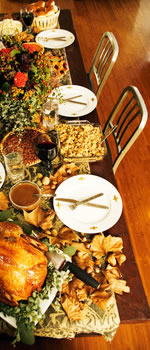 |
Khai McBride Certified Mortgage Planner Skyline Financial Corp. Phone: 800.399.6890 Fax: 800.399.6891 khai@mcbridegroup.com www.mcbridegroup.com |
 | ||
| ||||
November 2006

|
Cooking at Home for the Holidays By Kirk Leins
If you noticed a tinge of sarcasm in my opening words, it's because I've never been a huge fan of any diet. Personally, I believe that balanced eating along with portion control and exercise is the way to go. Nonetheless, I'm here to say that we can all get along. Besides, my job is not to judge your lifestyle, especially if it works for you. Rather, it's about showing you that home cooking is the key ingredient (pun intended) to any diet or lifestyle. Cooking at home allows you to control the process. In a day and age when nothing seems to be under our control, it's somewhat of a refreshing thought. Whether you're going low-carb or low-fat, Atkins or South Beach, Weight Watchers or The Zone – cooking at home is the insurance policy you need to stick to your plan. So let's explore some diet-friendly recipes you can make which will have your guests asking for seconds. For starters, let's talk turkey. Whether you're trying to boost your protein or lower your fat and cholesterol, turkey is the way to go. Not only is it a Thanksgiving mainstay, but turkey makes for a wonderful Christmas or Hanukkah dinner. It also happens to be extremely diet friendly. According to www.wholehealthmd.com, 3 ounces of skinless white meat turkey has only 1 gram of fat, 0 grams of carbohydrates, and a whopping 26 grams of protein. Not too shabby, no matter what diet you're on. Did you know that keeping the skin on or eating dark meat pieces will raise the fat content, but that's it? The protein and carbs stay the same. Most of you who are reading this probably have some experience with roasting a turkey. And most have probably done something like the following: smear a room temperature bird with butter, season it with salt and pepper, plop it in a roasting pan and bake in the oven at 325 degrees for 10 minutes per pound. It's pretty much the basic way to cook a bird. But how do you feel about doing something a little different this year? What if I told you that by adding one extra step to the aforementioned recipe, you could end up with a most excellent holiday turkey? Now that I've gotten your attention, I'm talking about brining. For anyone who's unfamiliar with the process, brining is nothing more than marinating meat in a solution of water, salt, sugar, and various spices. It usually takes a couple of days to brine a bird, but the end product is a flavorful, succulent turkey. Here's what you need to do: Turkey & Gravy You may have noticed that I opted not to stuff the bird. My reason is two-fold. For starters, turkey stuffing is already full of carbs; and if you cook it inside your bird, it will also be full of fat. My suggestion is to make your regular stuffing recipe but bake it in a casserole dish alongside your turkey. Make sure to substitute any whole eggs with double egg whites, and add extra chicken stock. The result will be a moist dressing with a crispy top. Low carbers can avoid it more easily, and everyone else can enjoy a low-fat stuffing. Mashed potatoes are also going to be an issue. Once again, low-carbers will avoid these like the plague, but a healthy alternative for everyone else can be made. Here's what you do: Mashed Potatoes So now that we've gotten our healthy versions of meat and potatoes out of the way, we need a few more side dishes that everyone can enjoy. In the spirit of the holidays, there's no better way to accommodate every lifestyle than with vegetables… and lots of ‘em! Everyone from vegetarians to Zone dieters will love you for it. Traditional veggie side dishes for a holiday meal would either be a string bean casserole or candied yams with marshmallows. In both cases, you will be alienating somebody. The beans are loaded with fat, and as for the yams, carb city. I'm not a huge fan of either of these dishes to begin with, but the low-fat/low-carb versions are really pretty hideous. Instead, I'd keep it simple. For a green veggie I'd go with something like a green bean almondine. Here's a simple way to make a healthy version of this classic dish. Green Bean Almondine So now that you've got your veggie, how about a salad? I know it's not something typically found at a holiday dinner table, but why not? Turkey with dressing, mashed potatoes and gravy, green bean almondine, and a salad. Sounds great to me! If you've got a great green salad, serve that. If you don't want to add a lot of work to your day, toss baby greens in a little olive oil and your favorite vinegar. Whatever the case may be, salads are very easy to conform to both low-carb and low-fat diets. Salads are also short on calories, so they're a great way to add food to the table without adding inches to your waistline. Now that we've gotten our holiday dinner out of the way, let's talk about a few things that make up the periphery of a holiday gathering. I love egg nog, but darn if it isn't loaded with fat, carbs, and calories. My suggestion is to use only the low-fat egg nog mix, and limit yourself to just one cup. Quality vodka mixed with diet tonic and a squirt of lime served on the rocks isn't a worthy replacement, but it's a lovely pre-dinner cocktail, nonetheless. The best part is it's got zero carbs. Dessert is one of the best parts about holiday food and an obvious killer for any diet. I have two schools of thought on how to handle this subject. One way is to eat the real deal but to do so with temperance and self-control. The other is to completely keep that stuff out of your house. Only you know which one is right for you. If you decide to go with option number two, my suggestion is to keep a selection of low fat/low-carb sweets on hand, as well as a selection of fresh fruit. My guess is that at some point you and your guests will want something sweet - so be prepared! Good luck and happy holidays! | ||||||||||||||||||||||||||||||
You are receiving a complimentary subscription to YOU Magazine as a result of your ongoing business relationship with Khai McBride. While beneficial to a wide audience, this information is also commercial in nature and it may contain advertising materials. INVITE A FRIEND to receive YOU Magazine. Please feel free to invite your friends and colleagues to subscribe. SUBSCRIBE to YOU Magazine. If you received this message from a friend, you can subscribe online. UNSUBSCRIBE: If you would like to stop receiving emails from Khai McBride, you can easily unsubscribe. Skyline Financial Corp. |
26840 Agoura Road Calabasas, CA 91301 Powered by Platinum Marketing © Copyright 2025. Vantage Production, LLC. | |||||||||


